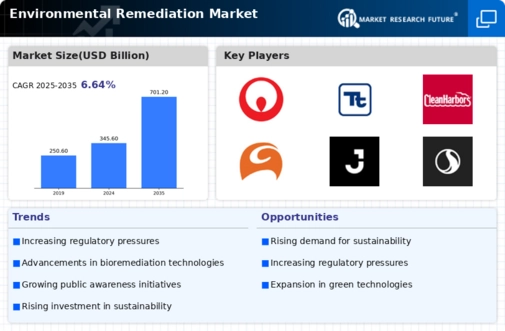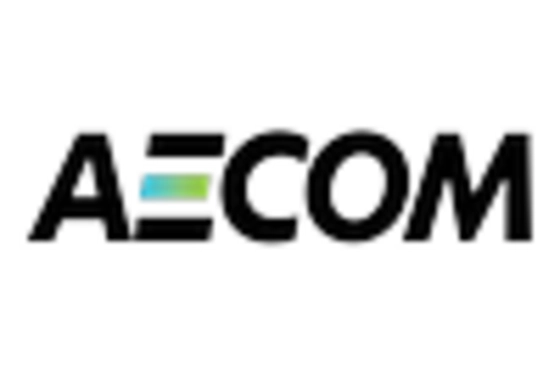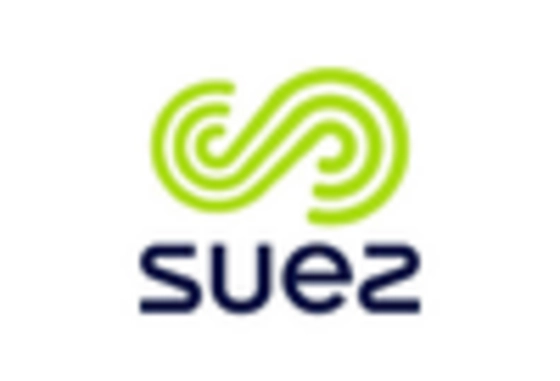Growing Public Awareness
Public awareness regarding environmental issues is on the rise, which appears to be a significant driver for the Environmental Remediation Market. As communities become more informed about the impacts of pollution and contamination, there is an increasing demand for transparency and accountability from corporations. This heightened awareness often translates into public pressure on companies to adopt sustainable practices and remediate contaminated sites. Surveys indicate that a substantial percentage of consumers are willing to support businesses that prioritize environmental responsibility. Consequently, organizations are more inclined to invest in remediation efforts to enhance their public image and meet consumer expectations. The Environmental Remediation Market is thus likely to experience growth as businesses respond to this societal shift towards environmental stewardship.
Technological Innovations
Technological advancements in remediation techniques are playing a crucial role in shaping the Environmental Remediation Market. Innovations such as bioremediation, phytoremediation, and advanced oxidation processes are enhancing the efficiency and effectiveness of remediation efforts. These technologies not only reduce the time and cost associated with traditional methods but also minimize environmental impact. The market for these advanced solutions is projected to grow significantly, with estimates suggesting a compound annual growth rate of over 10% in the coming years. As organizations seek to adopt more effective and sustainable remediation practices, the Environmental Remediation Market is likely to benefit from the integration of these cutting-edge technologies, leading to improved outcomes in site clean-up and restoration.
Increasing Industrialization
The rapid pace of industrialization across various sectors appears to be a primary driver for the Environmental Remediation Market. As industries expand, they often generate hazardous waste and pollutants, necessitating effective remediation strategies. In recent years, the demand for remediation services has surged, with the market projected to reach approximately USD 150 billion by 2026. This growth is indicative of the increasing need for companies to comply with environmental regulations and mitigate their ecological footprint. Furthermore, industries such as manufacturing, oil and gas, and mining are particularly scrutinized for their environmental impact, thereby propelling the demand for innovative remediation technologies. The Environmental Remediation Market is thus positioned to benefit from this trend, as companies seek to address contamination issues and enhance their sustainability practices.
Stringent Environmental Regulations
Regulatory frameworks governing environmental protection are becoming increasingly stringent, which significantly influences the Environmental Remediation Market. Governments worldwide are implementing more rigorous standards for waste management and pollution control, compelling organizations to invest in remediation solutions. For instance, the introduction of the Clean Water Act and the Resource Conservation and Recovery Act in various regions has heightened the accountability of businesses regarding their environmental practices. This regulatory pressure is expected to drive the market, as companies strive to avoid hefty fines and reputational damage associated with non-compliance. The Environmental Remediation Market is likely to see a rise in demand for services that ensure adherence to these regulations, thereby fostering innovation and investment in advanced remediation technologies.
Investment in Infrastructure Development
Investment in infrastructure development is emerging as a key driver for the Environmental Remediation Market. As urban areas expand and new construction projects are initiated, the potential for soil and water contamination increases. This necessitates the implementation of remediation strategies to address existing contamination and prevent future environmental degradation. Governments and private entities are increasingly allocating funds for infrastructure projects, which often include provisions for environmental assessments and remediation efforts. The market is expected to see a boost as these investments translate into demand for remediation services. Furthermore, the Environmental Remediation Market is likely to thrive as stakeholders recognize the importance of integrating environmental considerations into infrastructure planning and development.


















Leave a Comment